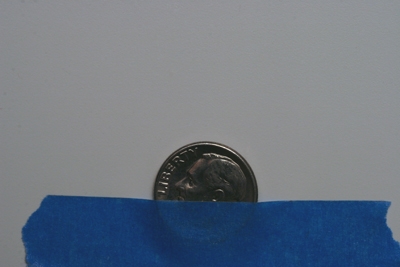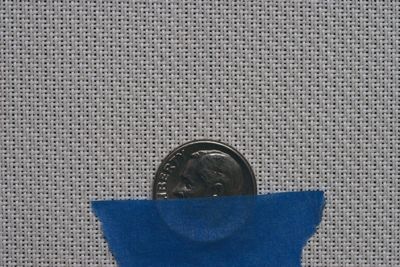Private Screening Page 3
The Results
The performance differences among these screens are subtle. At a comfortable viewing distance of 13 feet away, I could barely tell the difference between the various white screens, even though I could easily measure differences. And although I measured variances in the sonic effects of the woven screens, all I could really hear with any of them was a mild roll-off in the upper treble.
Da-Lite JKP Affinity

Most of today's conventional screens are coated with a material that has visible grain. Video guru Joe Kane (the "JK" in =JKP) says this grain creates interference with the tiny pixels of 1080p projectors. For the JKP Affinity screen, Da-Lite uses a coating it claims is so fine it can't interact with pixel patterns. The material is just very slightly gray, with a gain of 0.9. A motorized model is planned, and models with motorized masking for different aspect ratios are available. A 106-inch wide 2.35:1 model costs $2,418.
I measured the JKP Affinity's actual gain at 0.95. Brightness dropped considerably in the corners for a near-white screen, by an average of 22%. On-axis color response was practically perfect. But the measurements don't reveal the magic of watching a neutral screen like this in a black-hole environment. The picture seemed to float in space, as it does in a commercial cinema, but even better. The combination of the JKP Affinity screen, the JVC projector, and the Panamorph lens drew me into the action like never before.
Was this the magic of Da-Lite's fine-grain coating, or just the effect of a screen without gain? To find out, I borrowed something similar to the JKP Affinity: Stewart's StudioTek 100 1.0-gain screen. The Da-Lite did seem to convey slightly more detail, but the StudioTek's brightness was more uniform across the screen. (I n fact, it was essentially perfect.) Performance differences between the two made it impossible to match the white and black levels for a fair comparison. In the end, the pictures looked a little different, but neither looked consistently better than the other. In the black hole, they both looked better than everything else I tested.
$2,418 (as tested) / da-lite.com
Elite Screens AcousticPro1080

A 103-inch 2.35:1 version of Elite Screen's AcousticPro1080 comes in at a mere $1,342, making it the least - expensive woven screen we've encountered.
The rated gain of the AcousticPro1080 material is 1.0; I measured it at 0.67. Brightness uniformity was excellent - in fact, the gain increased in the corners by an average of 5%. Color shift on-axis was mild, with a very slight emphasis on green. Its audio response measured +1.9/-10.3 dB on-axis and +1.3/-5.0 dB off-axis. The measurement is essentially flat below 8 kHz, and that -10.3 dB dip is narrow, so acoustically it's at least the equal of its more expensive competitors.
The screen looked good at 13 feet. I suspect that only a very serious videophile would consider this a step down from models costing much more. But at 3 or 4 feet, I could see thin red-and-green vertical moiré patterns in bright areas of the picture. Zooming in or out a bit fixed the problem - it seems I just happened upon the one image size at which this material doesn't work well with the JVC projector. Elite Screens' rep said the company had never experienced the problem with DLP and LCD projectors.
$1,342 (as tested) / elitescreens.com
Screen Excellence Enlightor 4K

The pixels of the new ultra-high-resolution 4K projectors are even smaller than the threads in a typical woven projection screen. Only a handful of 4K projectors even exist, yet Screen Excellence has already addressed this problem with its Enlightor 4K material, which looks more like a fine fabric than like a typical woven screen. It's available only in a fixed frame; the package costs $3,595 in a 106-inch-wide 2.35:1 size. Motorized masking is available, as is a curved frame.
At 0.76, the Enlightor 4K's gain measured lower than its stated gain of 0.98. But its brightness uniformity was superb, with an average gain increase of 4% in the corners. Color response was essentially flat. Acoustically, it measured +2.4/-9.0 dB on-axis, +0.2/-6.9 dB off-axis - comparable to the peaks and dips I measured for the Screen Research screen - but the Enlightor 4K also diminished the treble by 2 to 3 dB between 1.5 and 8.5 kHz.
The Enlightor 4K's finely woven material appealed to the perfectionist videophile in me. While I can't say its picture looked noticeably better at a distance than those of the other woven screens, it definitely looked better close up. It was the only woven screen that could resolve the JVC projector's pixel pattern. I imagine that with a 4K projector, the difference would be even more dramatic.
$3,595 (as tested) / screenexcellence.com




























































